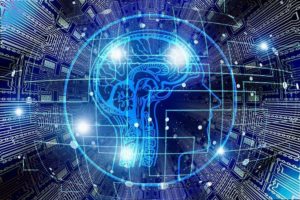The technology of Artificial Intelligence has made its way across diverse industries over the last few years, and its impact on the healthcare industry, especially in the field of radiology, is absolutely clear. AI has a huge range of potential and applications in radiology, ranging from improving diagnosis to enhancing workflow, thereby shifting a human radiologist’s role. The ability to examine endless amounts of images and data has driven the innovation of AI into the field of radiology, but due to its defined roles and data applications, its future in the industry remains questionable.

While drivers are being replaced by automated vehicles and pilots are being replaced by autopilot systems, doctors and radiologists are also feeling unsafe and they are being alarmed by predictions that they will soon be replaced by robots. But that’s not true. The fact is that AI will not replace human radiologists, but it will only enhance and support their work.
Role of Artificial Intelligence in Radiology
Over the last few years, AI has become an integral part of radiology, owing to the fact that it never sleeps, it never gets tired, and it can browse through an endless number of images without asking for any pause. No doubt, AI has added immense value in the field of radiology. Over time, it has become an extra team member for radiologists and has been extremely helpful in expediting patient diagnosis, examination and treatment across the neck, chest and head regions.
AI helps in prioritizing patients based on the severity of their condition so that diagnosis and workflow for urgent cases can be reshaped accordingly. Apart from that, AI proves to be of great help during times of immense workloads. It also helps in exact diagnosis and examination, as it can flag something on a scan that radiologists missed previously. This potentially reduces the chances of errors in diagnosis and reduce risks of physician burnouts.
All in all, AI steps is as an extra support member for a radiologist, who can take away a large part of the workload from a physician’s head and gives them a sense of security and support. Once their diagnosis weight is picked up by the AI, they can now focus on more complex cases that cannot be done without a specialist’s attention. Last but not least, AI can speed up Report Turnaround Times by speeding up the workflow and expediting the process of developing and delivering reports.
Replacement of Radiologists by AI
AI is able to spot details that are too subtle for a radiologist’s human eyes to see. It is also able to develop innovative ways to interpret medical images that are most difficult for humans to understand. With this, the accuracy of diagnoses has been improved significantly, due to which treatment has become possible in areas where radiologists are not easily available.
AI is entering the field of radiology at a very rapid rate. Radiologists are accepting it with great excitement, as it will reduce their workload, but at the same time, they have a fear of losing their jobs to it. The fact is that although AI is patterned in conjunction with the human brain, it does not equate to human intelligence in any way. It is not generalist; however, it is good at very specific things only. Although AI can correctly detect and diagnose images even better than a human radiologist, a radiologist’s job is not limited to diagnosing and examining medical images. They have to carry out a wide range of other work as well, including ultrasounds, biopsy, fluoroscopy, training, teaching, reviewing and serving on boards. AI may help a physician to handle much more data at increased speeds, and help in prioritizing patients and cases. But that is far enough from replacing a radiologist entirely.
All in all, radiologists have no reason to fear about getting replaced by AI and losing their jobs. In no way, AI can handle all the general roles of radiologists that they have to perform in their clinic. The key is that radiologists should accept the new advancements being made in the field, and improve their specialty by learning better about the latest equipment and identifying their strengths and weaknesses. AI is sure to drastically change the way radiology works, but there is still a most certain need of a human radiologist. Instead of saying ‘AI will replace radiologists’, the right statement would be ‘Radiologists who accept AI will replace those who don’t’.
Thereby, here I’m leaving you with a thought. Calculator never replaced mathematicians, autopilots never replaced human pilots, and MS Excel never replaced accountants. All these tools are designed to enhance and speed up the human process and make their work more productive. AI in radiology is no different.
But you would need the best software to gain maximum AI benefits in the field of radiology. sepStream® is dedicated to offering the best quality software at affordable rates. With an emphasis on individual needs, we offer customer-friendly products and services to take care of each and every need of our clients.